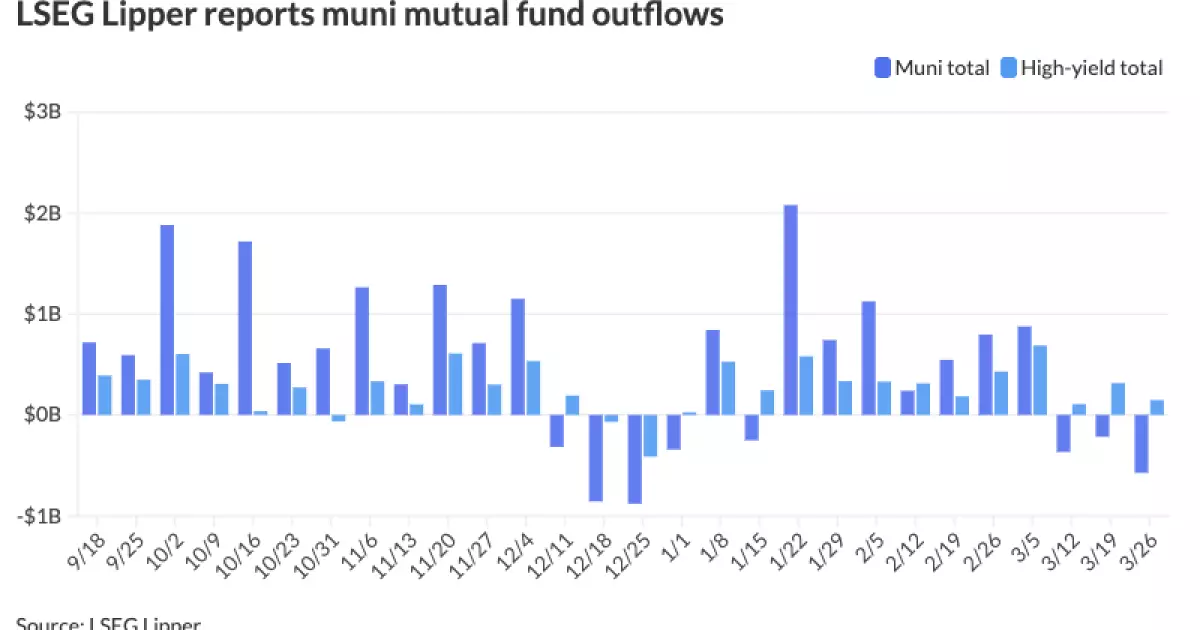Municipal bonds are often viewed as a safe harbor for investors looking for stability in volatile markets. However, current trends reveal that this perception might be misleading. With yields on municipal bonds rising, many argue that the traditional appeal of these investments is waning. The recent trajectory observed in municipal bonds mirrors a broader uncertainty in financial markets; they seem just as vulnerable to shifts in sentiment, interest rates, and economic fundamentals as their corporate and treasury counterparts.
As Kim Olsan, a senior fixed income portfolio manager, pointed out, the month has been defined by a relentless upward push in rates due to weak economic fundamentals and a slew of headwinds. This increasing yield backdrop is concerning, particularly for those who have used municipal bonds as a safe haven from market upheaval. It’s almost ironic that as we aim for greater security via these bond investments, we find ourselves dancing on the edge of riskier territory.
Heads Up: Municipal Yields are Rising
The current state of municipal bond yields has raised eyebrows, especially when agreeing with U.S. Treasury (UST) yields on the path upwards. In recent transactions, yields on longer bonds have shot up, leading to concerns about potential corrections within the market. The latest figures reveal that the two-year municipal to UST ratio stands at a mere 69%, while the 30-year ratio is at 91%.
The disconcerting reality is that investors are faced with a higher yield range than seen in the past six months. With yields now exceeding 3.00%, it forces the question: are we witnessing a sea change in how safe these supposedly mellow assets actually are? The gap between generic AAA credits and previous yields suggests that investors may need to rethink their strategies. What was once viewed as the “set it and forget it” approach may now be a path toward potential financial folly.
The Burden of Dealer Inventories
In an environment where market conditions are changing rapidly, high dealer inventories—reaching unprecedented levels—signal trouble ahead. They climbed to a jaw-dropping $15.4 billion, the highest since mid-December, which means a saturated market is the last thing we need right now. When distribution becomes a major challenge, the opportunity for liquidity decreases, making it increasingly difficult to sell bonds without a significant price cut.
One can argue that this saturation of inventory presents both a challenge and an opportunity. For smart investors willing to sift through the noise, challenging market conditions often yield attractive risk-adjusted returns. Yet, with such weighty inventories, it’s equally likely that yields will continue to rise, necessitating heavy evaluation before any purchases are made. The financial landscape is shifting, and the seemingly calm waters of municipal bonds are rapidly turning into choppy seas.
The Upside of Higher Yields: Opportunities Await
Despite the troubling signals, there is a silver lining amidst rising yields. Higher bond yields have historically fortified attractive prospects for value-seeking investors. Olsan noted that potential returns above 4.00% could expect to approach total returns exceeding 100% in high-quality 5% coupons.
The uncertainty invites scrutiny on specific credits that may savor renewed interest in this environment. The changing landscape also allows for discerning buyers—those willing to examine the nuances of coupon structures and call features—to seize opportunities for greater yield optimization. With premium coupons and panel credits becoming more competitive, the potential for gain remains vibrant amid trepidation.
The Disconnect: Investor Behavior and Market Realities
Investor behavior currently reflects a disconnect between the realities of the market and the emotions often attached to bond investments. The outflows from municipal bond mutual funds this week, totaling $573.3 million, are concerning indicators of how investor sentiment can ricochet through the markets. Fund flows establish a backdrop against which we must evaluate risk and growth potential. With high-yield funds receiving inflows when tax-exempt securities bleed out, there’s a fundamental question at play: when does the wisdom of crowd mentality become counterproductive?
Maybe the retail investor, in their desire for yield, is setting themselves up for a fall. The allure of higher returns should not blind investors to the foundational risks that have caused these outflows. This environment demands engaged thinking and scrutiny, rather than paralyzing fear or impulsive decisions, a theme that frequently reemerges in discussions about equities and fixed income alike. Ignoring changes in fundamentals can lead one down the wrong path, locking in longer than anticipated duration risk in a rising yield environment.
Through all these dynamics swirling around, it’s clear that anyone still hoping to secure a safe bet via municipal bonds in today’s market must remain both cautious and observant. The landscape suggests not a time to escape risk entirely but to redefine what risk means in an age of rising rates.

